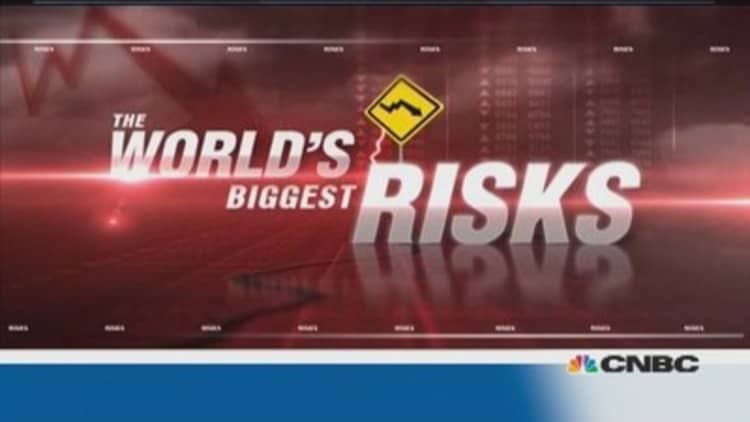Extreme weather poses one of the biggest risks to the global economy, experts warn, with some of world's largest cities in danger of being caught off-guard.
In its recent Global Risks report for 2014, the World Economic Forum (WEF) ranked extreme weather events – such as floods, storms and fires – at six in its top 10.
It comes after "exceptionally high losses" from weather-related catastrophes in 2013, according to European reinsurer Munich Re. One of the strongest cyclones in history — Supertyphoon Haiyan in the Philippines — pushed global losses to $125 billion for the year, the group said.
In 2012, global losses came in at $160 billion and were boosted by Hurricane Sandy which caused massive flooding in New York City. The superstorm accounted for $50 billion in losses, left millions without electricity and destroyed thousands of homes and businesses.
(Read more: Extreme weather causes $125 billion insurance bill: Munich Re)

But although volatile weather conditions can hit anywhere in the world, it is the risk posed to the world's cities that has analysts most worried.
Hurricane Sandy proved that no city is immune to natural disasters, according to Richard Hewston, principal environmental analyst at risk analysis company Maplecroft.
"New York City itself was quite well prepared — the forecasting was spot on. People were evacuated; the businesses had contingency plans," he told CNBC. "It shows that no city is impregnable."
The potential damage caused by a storm on a city is weighing on investors' minds, according to Jacques Gordon, global strategist at LaSalle Investment Management, a real estate investment manager with $47.6 billion of assets under management.
"New York was a big wake-up call, as was the Philippines' typhoon," he told CNBC. "We're not done with this. Volatile weather is going to be a major news story looking ahead."
(Read more: Hurricane Sandy special report)
Cities in danger
As the world's cities get more and more crowded, these weather events — known as "perils" in the insurance industry — pose an increased danger to built-up urban areas. And cities are especially vulnerable to one of the most damaging weather risks: floods.
"If we look at where major cities are located, they are frequently found along coasts and rivers - mainly because of transport links," Peter Hausmann, head of catastrophe peril for Europe at reinsurer Swiss Re, told CNBC.
"Coastal areas are at high risk of the impact from the sea, storms, storm surges, or tsunamis; while cities on the world's largest rivers are at risk of major floods."
And as cities get more crowded, so the risk of damage from natural catastrophes increases.
"You have this growth of mega-cities and a rapid urbanization of smaller cities… which puts an added strain on infrastructure and institutions, which are often poorly prepared to cope with natural hazards," Hewston added.
Asia concerns
And it is Asia's megacities that are generating the most concern about their ability to cope with extreme weather.
Japan's Tokyo, Manila in the Philippines and China's Pearl River Delta region — one of the most densely urbanized areas in the world — top Swiss Re's list of cities most at-risk in terms of population. Only one non-Asian city, Los Angeles, made the top 10.
The insurer named the Pearl River Delta — which includes Hong Kong, Shenzhen, Dongguan, Macau and Guangzhou — as number one when looking at the number of people potentially affected by storm, storm surges and river floods.
(Read more: Will typhoon Haiyan derail Philippines' economy?)
Over 17 million people in the region could be affected by an extreme storm, for example – that's over 40 percent of the people that live in the metropolitan area.
Meanwhile, the value of working days lost as a result of a strong typhoon, for instance, which Swiss Re said could reach up to a "low two-digit billion dollar" figure, —1-2 percent of the region's annual gross domestic product (GDP).
"It's really important to point out that Asia has a huge risk if we look at a whole globe - that's my key message," Hausmann said.
"Unfortunately, protection measures are limited there, and also the insurance penetration is in parts really low. We expect there — sooner or later — to be another major event (in the region), and the impact will be terrible."
But although many European and U.S. cities have smaller populations, Swiss Re warned that a number could face huge economic repercussions in the event of a major disaster. The Netherlands' Amsterdam-Rotterdam, Los Angeles, New York and Paris all make Swiss Re's top ten when the potential value of working days lost as a result of nature disasters is calculated.
Economic impact
Because of the amount of damage — and the cost of repairs — that a natural disaster can cause on a city, experts warn that natural disasters have serious implications on a national level, especially in emerging economies.
Take Typhoon Haiyan, for example, which tore across the southern Philippines in November 2013 and killed over 6,000 people. The cost of the storm was $10 billion, according to European reinsurer Munich Re – around 5 percent of the country's GDP.
By contrast, the overall loss of New York's Superstorm Sandy was significantly higher at $50 billion, but accounted for 0.3 percent of the U.S.'s annual GDP in 2012.
This is because in emerging economies, cities often dominate a country's GDP, Hausmann explained. Economies were particularly at risk if key industries were concentrated in one place, Hewston added.
"Take, for example, the delta of Bangladesh where there's huge amount of agriculture — and half of the rice crop for the year is wiped out — that would have seriously consequences for the national economy," he said.

Sectors at risk
And it's not just agriculture that is at risk of extreme weather. LaSalle's Gordon said that volatility in weather patterns was certainly concerning property investors, and insurance premiums were already starting to rise.
As a result, flooding in particular could have a real impact on global real estate, he said.
"Coastal real estate could potentially fall in value as this becomes a repeated problem in the next five years," he said, adding that some people may even sell property in port cities like Hong Kong and head to higher ground.
(Read more: How businesses can prepare for the next Sandy)
"There is also wide-ranging business disruption," Gordon added. "Every firm can be hit hard by this — it's bigger than just property."
Tourism was another sector that was often hard hit by extreme weather, according to Hewston, who stressed that some of the regions most at risk of disasters were burgeoning tourist hotspots.
South East Asia, for example, is home to a string of popular tourist cities including Bangkok in Thailand, Jakarta in Indonesia and Manila in the Philippines. Tourism accounted for 4.4 percent of the region's total GDP in 2012, according to the World Travel and Tourism Council, and is forecast to rise by 6.9 percent in 2013.
"There is an increasing number of people who want to travel further afield to areas like South East Asia. These haven't typically haven't been holiday destinations in the past, but are now exploding," he said. "Even in terms of reputational damage, a natural disaster could have huge consequences."
However Hausmann stressed that by their very nature, extreme weather events would always have wide-ranging effects.
"Overall, these are rare events — that is important to point this out — but they are such huge events that typically a whole metropolitan area is affected, and as such the whole economy is heavily affected."
—By CNBC's Katrina Bishop. Follow her on Twitter @KatrinaBishop and Google





